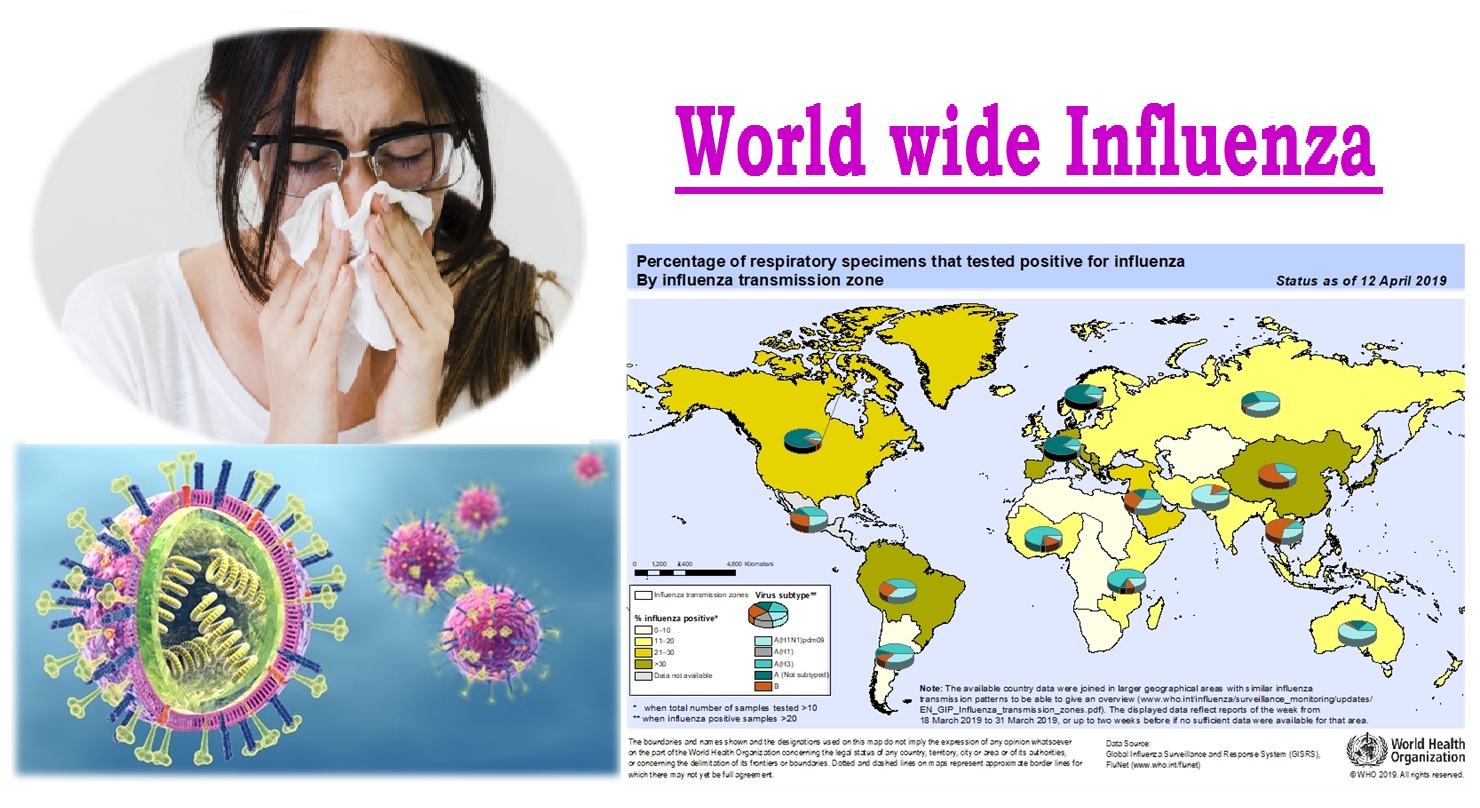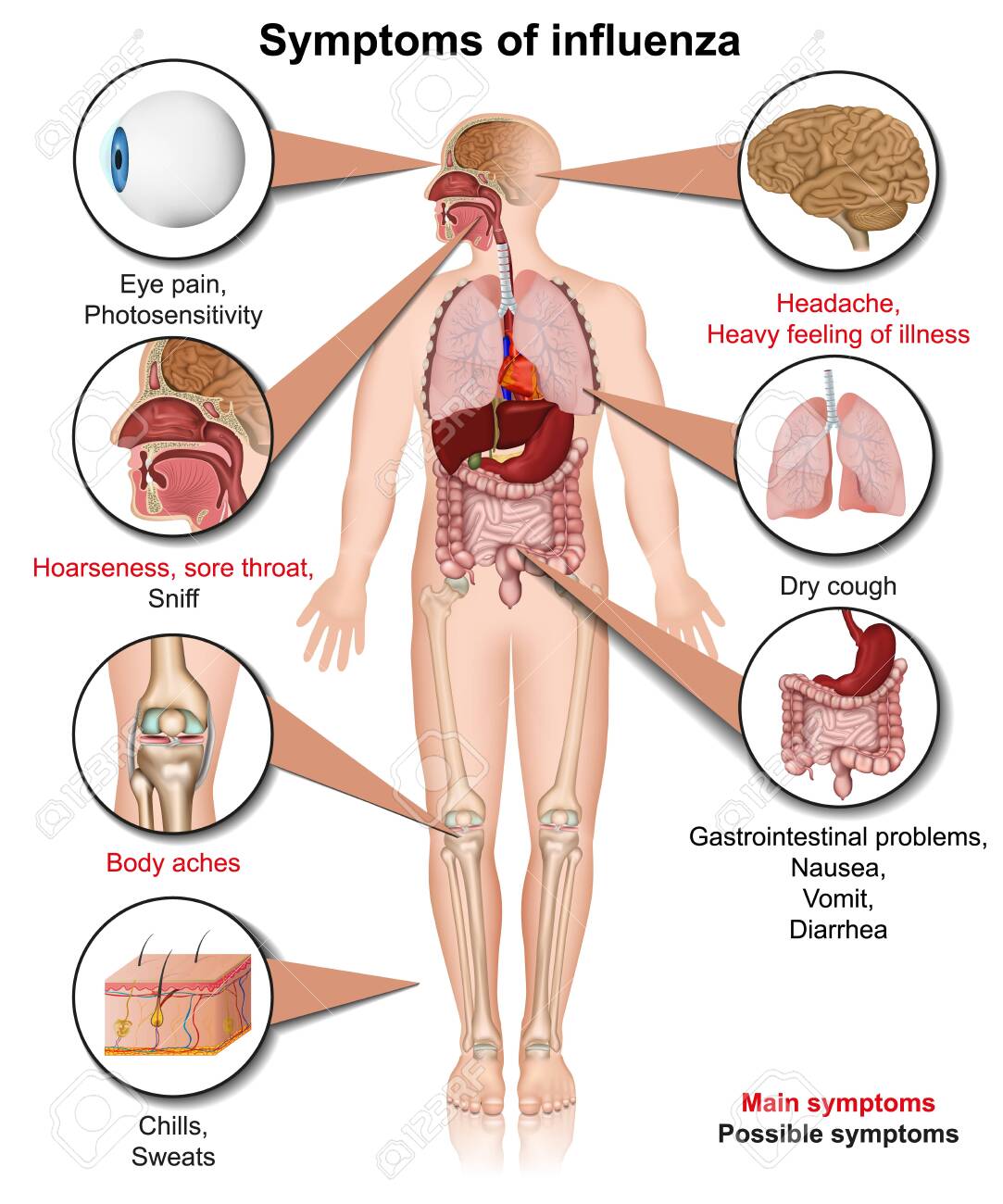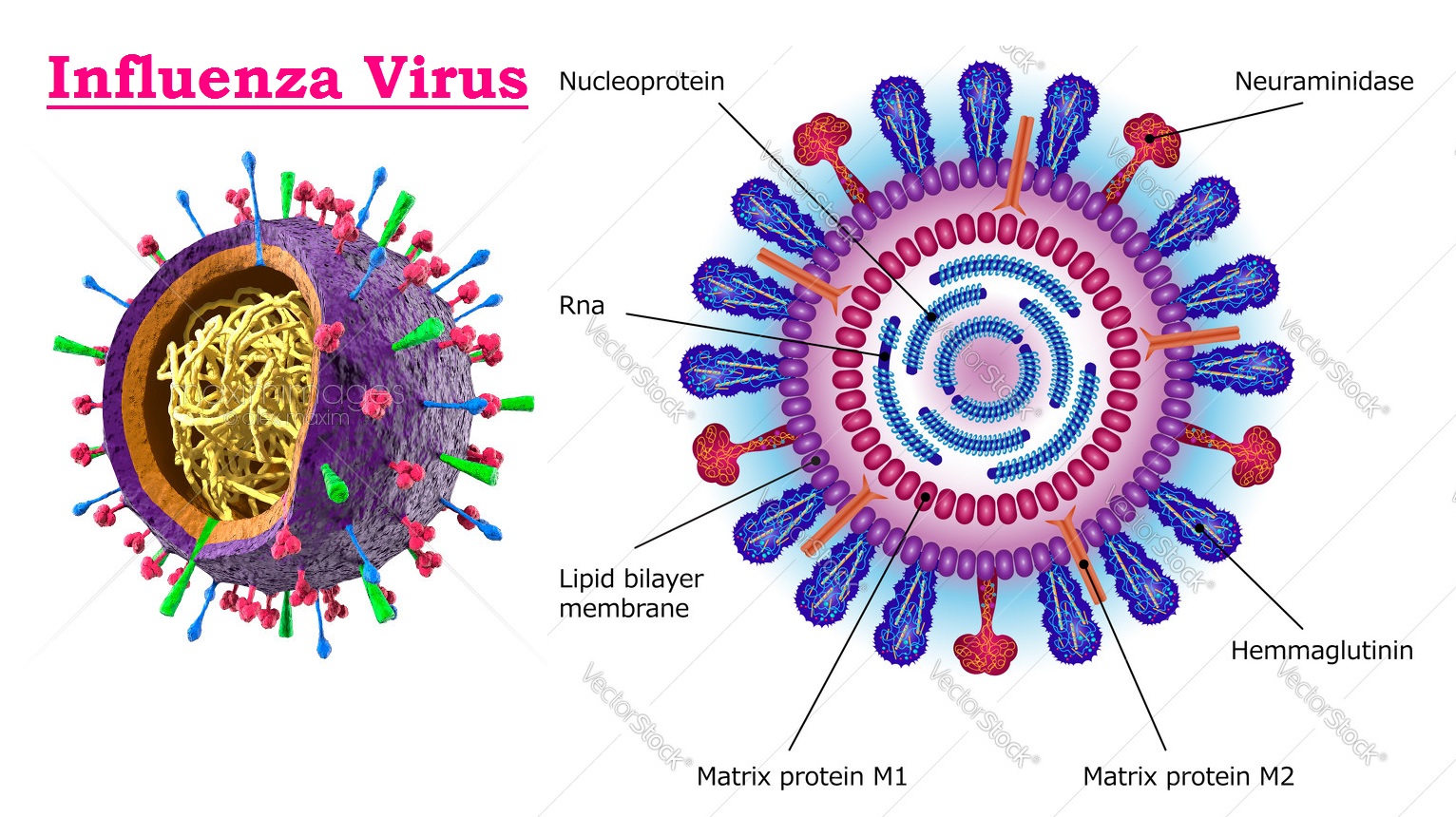Influenza (Flu)
Influenza is an infectious disease caused by an influenza virus. It's commonly known as "Flu". Symptoms of the Influenza can be mild to severe and even death. The most common symptoms includes a high fever, runny nose, sore throat, muscle pains, headache, coughing and feeling tired. These symptoms typically begin two days after exposure to the virus and most last less than a week. The cough, however, may last for more than two weeks. In children, there may be nausea and vomiting, but these are not common in adults. Nausea and vomiting occur more commonly in the unrelated infection gastroenteritis, which is sometimes inaccurately referred to as "stomach flu" or "24-hour flu". Complications of influenza may include viral pneumonia, secondary bacterial pneumonia, sinus infections and worsening of previous health problems such as asthma or heart failure.
Influenza illnesses range from mild to severe and even death. Hospitalization and death occur mainly among high risk groups. Worldwide, these annual epidemics are estimated to result in about 3 to 5 million cases of severe illness and about 290 000 to 650 000 respiratory deaths. In industrialized countries most deaths associated with influenza occur among people age 65 or older. Epidemics can result in high levels of worker/school absenteeism and productivity losses. Clinics and hospitals can be overwhelmed during peak illness periods. The effects of seasonal influenza epidemics in developing countries are not fully known but research estimates that 99% of deaths in children under 5 years of age with influenza related lower respiratory tract infections are found in developing countries. 
World Health Organization last month released a list of 10 major threats to global health in 2019, which includes another global influenza pandemic. “The world will face another influenza pandemic. The only thing we don’t know is when it will hit and how severe it will be. Global defenses are only as effective as the weakest link in any country’s health emergency preparedness and response system," WHO said.
Health experts claim that India’s vulnerability in the last 100 years has remained unchanged and the country is yet not prepared to handle an influenza pandemic. WHO, in its latest global update on influenza released earlier this month, has highlighted that the cases in Europe, North Africa, Western Asia, East Asia, and southern Asia continue to increase.
India has recorded a total of 6,701 H1N1 (also called as swine flu or seasonal influenza) cases and 226 deaths across the country, according to National Centre for Disease Control (NCDC). The maximum number of cases has been reported from Rajasthan (2,363) followed by Delhi (1,011) and Gujarat (898). Rajasthan reported the highest number of deaths (85), followed by Gujarat (43) and Punjab (30). During the 1918 pandemic, India had the largest number of deaths in any country (10-20 million), as well as highest percentage of overall deaths in the world (4.39%). During the 2009 pandemic, India reported 27,236 cases with 981 deaths.
Sign & Symptoms
Approximately 33% of people with influenza are asymptomatic. Symptoms of influenza can start quite suddenly one to two days after infection. Usually the first symptoms are chills or a chilly sensation but fever is also common early in the infection with body temperatures ranging from 100 to 103 °F. Many people are so ill that they are confined to bed for several days with aches and pains throughout their bodies, which are worse in their backs and legs. Symptoms of influenza may include:
• Fever and extreme coldness [chills shivering, shaking (rigor)]
• Cough
• Nasal congestion
• Runny nose
• Sneezing
• Body aches, especially joints and throat
• Fatigue
• Headache
• Irritated, watering eyes
• Reddened eyes, skin (especially face), mouth, throat and nose
• Petechial rash
In children, gastrointestinal symptoms such as diarrhea and abdominal pain (may be severe in children with influenza B). It can be difficult to distinguish between the common cold and influenza in the early stages of these infections but a Flu can be identified by a high fever with a sudden onset and extreme fatigue. Influenza is a mixture of symptoms of common cold and pneumonia, body ache, headache & fatigue. Diarrhea is seen in few children but not normally a symptom of influenza in adults, although it has been seen in some human cases of the H5N1 "Avian Influenza".
Causes & Mode of Transmission of Influenza
Four main types of influenza viruses cause the flu: Type A, Type B, Type C and Type D. All three virus types are spread in the same way: they leave an infected person’s body in droplets whenever that person coughs, sneezes or puts their mouth on another object. The Centers for Disease Control and Prevention (CDC) report that a person with the flu can spread the virus to others up to six feet away. If a normal parson are in close contact with an infected person, he/she may end up inhaling infected droplets immediately. However, he/she can also pick up the virus later from touching an infected object (such as a door handle or a pencil) and then touching his/her eyes, nose, or mouth. Additionally, the Influenza is highly contagious. Most people experience Influenza symptoms within one to four days of getting sick. However, an infected person can begin spreading the Influenza virus to others one day before manifesting symptoms and for up to a week after getting sick. Hence, it is essential to maintain vigorous personal hygiene, especially during flu season. This includes simple steps, like using antibacterial liquid to clean hands after getting off a bus or washing hands extra carefully before eating. Such steps can go a long way when it comes to avoiding the Influenza and preventing its spread.
Pathogen (Influenza Virus)
There are 4 types of seasonal influenza viruses, types A, B, C and D. Influenza A and B viruses circulate and cause seasonal epidemics of disease.
Influenza A Virus :
Type A influenza virus is the most virulent form of influenza and the one that causes the most severe illness. This virus often originates in populations of wild birds, poultry or swine (including pigs and hogs); So different strains are sometimes referred to as avian (bird) or swine flu. Type A influenza is most active during colder weather in temperate climates and its peak season typically runs from late fall to early spring.
Type A influenza virus is categorized according to variations in two proteins on the surface of the virus: H (hemagglutinin) and N (neuraminidase). According to the CDC, there are 17 subtypes of the H protein and 10 subtypes of the N protein. Different protein combinations lead to different strains of the virus. H1N1 and H3N2 are two recent strains of Type A influenza virus. The two most active strains of Type A virus, H1N1 and H3N2 are usually included in each year’s influenza vaccine. If a new virus strain emerges that is not covered by the annual flu vaccine, a special vaccine is made to combat the new strain of virus. The United States government recommends that all individuals six months and older get a yearly flu vaccine.
Influenza B Virus :
Type B influenza is not divided into subtypes but the virus does mutate into different strains. Unlike Type A, Type B influenza is active throughout the year. Nevertheless, it generally causes a much milder form of the influenza than Type A viruses.
The strain of Type B virus most active in the population is usually included in the annual influenza vaccine.
Influenza C Virus :
Type C influenza is the least common type of the influenza and its symptoms are generally much milder than those of Type A or B influenza. Type C influenza is not included in yearly flu vaccines.
Influenza D Virus :
Influenza D viruses primarily affect cattle and are not known to infect or cause illness in people.
Diagnosis of Influenza :
Patient respiratory illness might be the influenza if the person have fever, cough, sore throat, runny or stuffy nose, body aches, headache, chills and fatigue. Some people may have vomiting and diarrhea. People may be infected with the influenza and have respiratory symptoms without a fever. Influenza viruses usually cause the most illness during the colder months of the year. However, influenza can also occur outside of the typical flu season. In addition, other viruses can also cause respiratory illness similar to the influenza. So, it is impossible to tell for sure if the person have the influenza based on symptoms alone. If doctor needs to know for sure whether he/she have the influenza, there are laboratory tests that can be done.
A number of flu tests are available to detect influenza viruses. The most common are called “rapid influenza diagnostic tests.” These tests can provide results in 30 minutes or less. Unfortunately, the ability of these tests to detect the influenza can vary greatly. Therefore, the person could still have the flu, even though his/her rapid test result is negative. In addition to rapid tests, there are several more accurate and sensitive influenza tests available that must be performed in specialized laboratories, such as those found in hospitals or state public health laboratories. All of these tests require that a health care provider swipe the inside of patient's nose or the back of throat with a swab and then send the swab for testing. These tests do not require a blood sample.
During an influenza outbreak, a positive rapid flu test is likely to indicate influenza infection. However, rapid tests vary in their ability to detect flu viruses, depending on the type of rapid test used and on the type of flu viruses circulating. Also, rapid tests appear to be better at detecting flu in children than adults. This variation in ability to detect viruses can result in some people who are infected with the influenza having a negative rapid test result. (This situation is called a false negative test result.). Despite a negative rapid test result, Health care provider may diagnose patient with influenza based on symptoms and their clinical judgment. Most people with influenza symptoms do not require testing because the test results usually do not change how the person are treated. Health care provider may diagnose influenza based on the symptoms and their clinical judgment or they may choose to use an influenza diagnostic test. During an outbreak of respiratory illness, testing for flu can help determine if influenza viruses are the cause of the outbreak. Influenza testing can also be helpful for some people with suspected flu who are pregnant or have a weakened immune system and for whom a diagnosis of flu can help their doctor make decisions about their care.
Treatment of Influenza
Usually, Patient will need nothing more than bed rest and plenty of fluids to treat the influenza. But in some cases, doctor may prescribe an antiviral medication, such as Oseltamivir (Tamiflu) or Zanamivir (Relenza). If taken soon after notice symptoms, these drugs may shorten illness by a day or so and help prevent serious complications.
Oseltamivir is an oral medication. Zanamivir is inhaled through a device similar to an asthma inhaler and shouldn't be used by anyone with respiratory problems, such as asthma and lung disease. Antiviral medication side effects may include nausea and vomiting. These side effects may be lessened if the drug is taken with food. Oseltamivir has also been associated with delirium and self-harm behaviors in teenagers. Some researchers recommend further study on both of these drugs because of uncertainty about their effects beyond a slight reduction in the time of illness. Some studies have suggested that these medications can also help reduce the severity of complications. The Centers for Disease Control and Prevention still recommends their use for some people.
An additional concern is that some strains of influenza have become resistant to Oseltamivir, Amantadine and Rimantadine (Flumadine), which are older antiviral drugs.
Prevention of Influenza
The most effective way to prevent the disease is vaccination. Safe and effective vaccines are available and have been used for more than 60 years. Immunity from vaccination wanes over time so annual vaccination is recommended to protect against influenza. Injected inactivated influenza vaccines are most commonly used throughout the world.
Among healthy adults, influenza vaccine provides protection, even when circulating viruses do not exactly match the vaccine viruses. However, among the elderly, influenza vaccination may be less effective in preventing illness but reduces severity of disease and incidence of complications and deaths. Vaccination is especially important for people at high risk of influenza complications, and for people who live with or care for the people at high risk.
WHO recommends annual vaccination for:
• pregnant women at any stage of pregnancy
• children aged between 6 months to 5 years
• elderly individuals (aged more than 65 years)
• individuals with chronic medical conditions
• health-care workers.
Influenza vaccine is most effective when circulating viruses are well-matched with viruses contained in vaccines. Due to the constant evolving nature of influenza viruses, the WHO Global Influenza Surveillance and Response System (GISRS) – a system of National Influenza Centres and WHO Collaborating Centres around the world – continuously monitors the influenza viruses circulating in humans and updates the composition of influenza vaccines twice a year.
For many years, WHO has updated its recommendation on the composition of the vaccine (trivalent) that targets the 3 most representative virus types in circulation (two subtypes of influenza A viruses and one influenza B virus). Starting with the 2013–2014 northern hemisphere influenza season, a 4th component is recommended to support quadrivalent vaccine development. Quadrivalent vaccines include a 2nd influenza B virus in addition to the viruses in trivalent vaccines, and are expected to provide wider protection against influenza B virus infections. A number of inactivated influenza vaccines and recombinant influenza vaccines are available in injectable form. Live attenuated influenza vaccine is available as a nasal spray.
Pre-exposure or post-exposure prophylaxis with antivirals is possible but depends on several factors e.g. individual factors, type of exposure, and risk associated with the exposure.
Apart from vaccination and antiviral treatment, the public health management includes personal protective measures like:
• Avoid close contact : Avoid close contact with people who are sick. When the parson are sick, keep the distance from others to protect them from getting sick too.
• Stay home when you are sick : If possible, stay home from work, school and errands when you are sick. This will help prevent spreading your illness to others.
• Cover your mouth and nose : Cover mouth and nose with a tissue when coughing or sneezing. It may prevent those around the patient from getting sick.
• Clean your hands : Washing hands often will help protect from germs. If soap and water are not available, use an alcohol-based hand rub.
• Avoid touching your eyes, nose or mouth : Germs are often spread when a person touches something that is contaminated with germs and then touches his or her eyes, nose or mouth.
• Practice other good health habits : Clean and disinfect frequently touched surfaces at home, work or school, especially when someone is ill. Get plenty of sleep, be physically active, manage stress, drink plenty of fluids and eat nutritious food.








Like!! Really appreciate you for writing this blog post. Really thank you! Keep writing.
Hi! I’ve been following your website for a while now and finally got the bravery to go ahead and give you a shout out from Humble Tx! Just wanted to tell you keep up the good work!